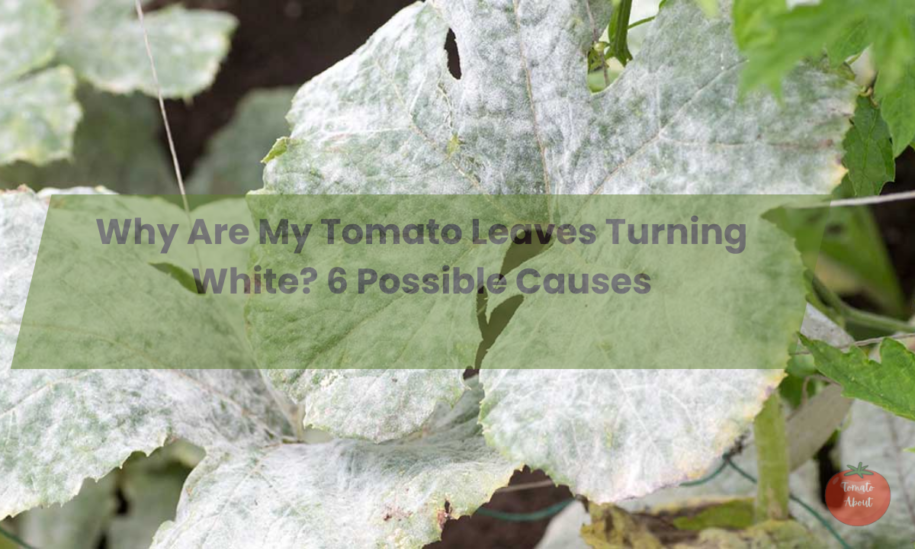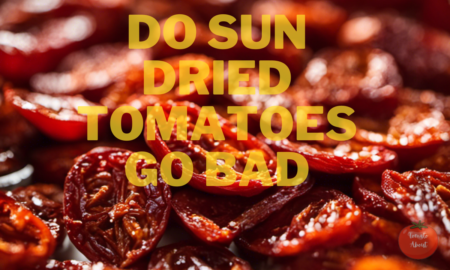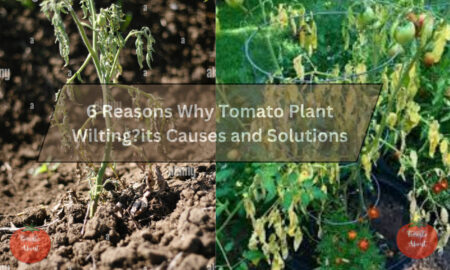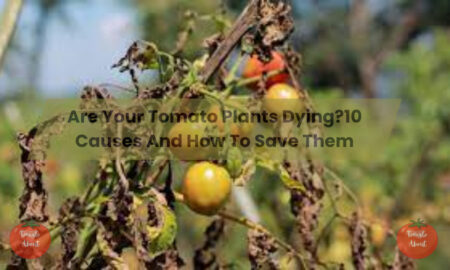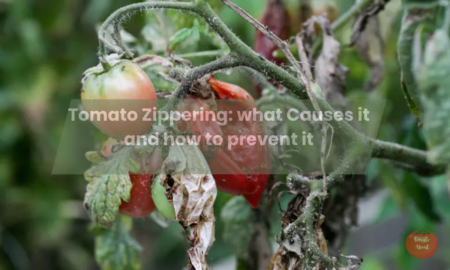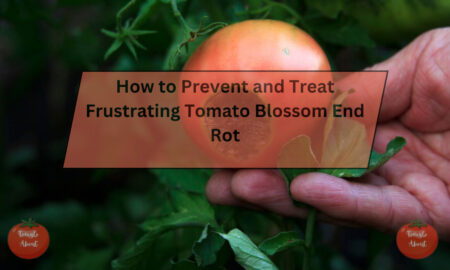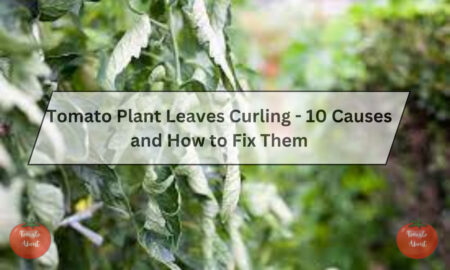It’s a sunny summer afternoon and you are eagerly anticipating the ripe, red tomatoes from your garden. But when you check on your plants, you notice the leaves are covered in unusual white spots.
This alarming sight is enough to give any tomato gardener pause. After all, the leaves are the food factories of your plants. When they are not functioning properly, your tomato harvest is at risk.
White spots or patches on tomato leaves are often early indications of disease or environmental stress. Left unchecked, these conditions can reduce yields and severely impact plant health.
The good news is that catching the causes early gives you the best chance of saving your crop. Here are the six most common reasons for white spots on tomato leaves and what you can do about them.
1. Powdery Mildew
Powdery mildew is a fungal disease that thrives in warm, dry, humid conditions. The optimal temperature range for development is 70-80°F.
This aggressive pathogen spreads easily via wind currents and insects. It overwinters in plant debris and compost.
You’ll first notice a white, powdery coating on the undersides of leaves. As the disease progresses, both sides of the leaves will be covered in a grayish fuzz. The coating may also appear on stems, flowers, and fruit.
How to Treat Powdery Mildew
- Prune and destroy seriously infected leaves. Be sure to sanitize tools before and after use.
- Apply neem oil, sulfur dust, or a dedicated antifungal spray weekly until the fungus clears.
- Improve air circulation around plants through proper spacing and selective pruning.
- Water at the soil line rather than wetting foliage.
- Keep nitrogen levels moderate to limit soft, fast-growing tissue, which is more susceptible to infection.
How to Prevent Powdery Mildew
- Choose resistant varieties like ‘Geronimo’, ‘Massada’, and ‘Panzer’.
- Space plants at least 24 inches apart and situate them where they’ll get ample sun.
- Avoid overhead watering and control humidity levels with drip irrigation and wider spacing.
- Scout regularly for early signs of fungal growth.
- Apply preventative sulfur sprays weekly in warm, humid conditions.
2. Sun Scald
If white patches appear on leaves soon after transplanting, sun scald could be the culprit. This condition develops when tender young plants transition from the shaded greenhouse into the harsh heat and light of the garden.
Sun-scalded areas first appear pale green, then turn white or silvery before browning. They may be accompanied by wrinkled, dehydrated tissue. If left untreated, affected leaves wither and die.
Fruits are also vulnerable to sunburn. Developing tomatoes exposed to intense afternoon sun may get large cracked blisters that remain white or tan as they mature.
How to Treat and Prevent Sun Scald
- Provide temporary shade for newly transplanted seedlings until they adjust. Gradually expose them to more sun over 7-10 days.
- Time plantings so mature plants have leaf canopy during the hottest months.
- Paint or spray fruit clusters with kaolin clay solutions to protect developing tomatoes. Reapply after rain.
- Maintain consistent soil moisture to reduce plant stress and susceptibility.
- Use fabric row covers to filter intense sunlight in midsummer. Remove during pollination.
To treat existing sunscald:
- Gently remove damaged leaves
- Move plants into the afternoon shade
- Mist leaves regularly to keep them cooler
- Wait for new, sun-acclimatized growth to appear
3. Early Blight
This fungal infection begins as small, dry, brown spots on older leaves near the ground. Spots expand rapidly into large, dark lesions with concentric rings that resemble a bullseye.
During humid, rainy periods, the centers of lesions may fall out, leaving holes in foliage. Repeated infection causes extensive yellowing, browning, and defoliation.
If the infection reaches developing fruits, you’ll see dark, sunken areas on tomatoes. These may have a slightly fuzzy grayish cast from spore production.
How to Treat and Prevent Early Blight
- Improve air circulation through wider planting, staking, and moderate pruning.
- Remove and destroy severely infected leaves and fruits.
- Apply copper-based fungicide sprays every 7-10 days during cool, wet weather.
- Rotate tomatoes to a different area of the garden each year to limit overwintering inoculum.
- Choose resistant varieties like ‘Legend’, ‘Mountain Merit’, and ‘Iron Lady’.
- Water in the morning so foliage dries quickly. Avoid wetting leaves.
- Add 2-3 inches of mulch to prevent spores from splashing back from the soil.
4. Septoria Leaf Spot
This disease emerges as small, circular spots on lower leaves following periods of leaf wetness. Spots are initially water-soaked and then turn white with dark edges.
Under rainy or humid conditions, lesions expand rapidly and take on a grayish cast from fungal growth. Leaves yellow between spots and eventually turns brown and crispy.
Though Septoria won’t kill plants outright, it weakens them significantly by destroying foliage. It also blemishes fruits with small black dots.
How to Treat and Prevent Septoria Leaf Spot
- Improve airflow and limit leaf wetness through proper spacing, staking, and watering habits.
- Remove and destroy infected leaves. Be sure to disinfect the tools afterward.
- Apply fungicide containing chlorothalonil every 7-10 days in warm, rainy weather.
- Water at the soil line in the morning and avoid wetting leaves.
- Space plants 18-24 inches apart and situate for plenty of sunshine.
5. Late Blight
This dangerous fungal invader spreads shockingly fast, destroying tomatoes within days. Lower leaves first develop pale green spots, then turn brown or black. Fuzzy white mold may cover leaf undersides in humid conditions.
Fruits exhibit large brown greasy spots. The tissue collapses, leaving rotten cavities. A thick white fungal growth may cover the affected fruit.
Once Late Blight appears, infected plants must be pulled immediately. Do not compost them.
How to Treat and Prevent Late Blight
- Monitor weather reports and scout regularly during cool, wet periods. Early detection is key.
- Remove symptomatic plants right away. Double bag and dispose of them offsite.
- Apply copper fungicide weekly as a protective barrier during seasons with Late Blight reports.
- Avoid planting tomatoes near potatoes. Both are susceptible.
- Disinfect tools and wash hands thoroughly after contact with affected plants.
- Purchase only certified disease-free transplants. Inspect them closely.
- Rotate planting location and avoid saving seeds from infected gardens.
When to Worry About White Leaves on Tomato Plants
Seeing a few white patches is no cause for alarm. But if the problem keeps spreading or whole sections of leaves rapidly turn white, take action to diagnose and resolve the issue.
Leaves that have already turned white won’t recover, so don’t leave diseased plants hoping they’ll rebound on their own. Catching issues early gives you the best chance of saving the plant.
Pay particular attention if white spots, stippling damage, or fading appears on younger top leaves rather than lower old growth. This indicates the problem is active and ongoing.
While an occasional white leaf here and there won’t hurt yields, extensive loss of foliage can stress plants. Photosynthesis is reduced, leaving tomatoes undersized or of poor quality.
6. Nutrient Deficiencies Cause Distinct Leaf Patterns
White spots or margins on tomato leaf edges may indicate a nutrient deficiency. This occurs if soil fertility is low or pH is off, preventing roots from accessing nutrients.
Common deficiencies include:
- Manganese – Causes gray spots and puckered new growth. Spray foliage with manganese sulfate or amend the soil with manganese oxide.
- Magnesium – Yellowing between leaf veins, eventually spreading to the whole leaf. Apply Epsom salts or calcium-magnesium supplements.
- Iron – Young leaves turn completely white while veins remain green. Use iron chelate soil drench or foliar spray.
- Zinc – Stunted plants with small, white-spotted leaves. Apply zinc sulfate or chelated zinc.
Without intervention, these deficiencies cause severe chlorosis and necrosis. However, correcting the specific nutrient lack quickly rebounds plants back to health.
Take a Soil Test to Get Ahead of Deficiencies
While visual patterns help identify the nutrient need, a soil test from your local extension provides exact fertility levels and pH.
This takes the guesswork out and tells you how much of each amendment to apply for your soil’s needs. I test my soil every 2-3 years to stay ahead of deficiencies. Addressing problems before planting prevents issues once crops are in the ground.
What to Do If All the Tomato Leaves Turn White
It’s certainly possible for all the foliage on a tomato plant to turn completely white. This is usually from severe sunscald, aggressive pest infestation, or a rapidly spreading disease taking over the plant.
If the stems and topmost newer leaves remain green and viable, don’t give up immediately. Prune off every affected leaf, even if it’s the whole plant. This removes the diseased/damaged tissue.
Care for the tomato as usual, and with luck it will put out fresh new leaves within a couple weeks. Supplement with a diluted organic fertilizer to aid recovery.
However, if the main stem has turned brown or the growing tips are shriveled, the plant is likely too far gone. Pull it and discard the remains far from your garden.
Focus efforts on protecting remaining plants from whatever caused the issue, be it insects, fungus, or excess light intensity.
Frequently Asked Questions
Q: Why are the leaves on only some of my tomato plants turning white?
A: If white leaves appear on just a few tomato plants, it generally indicates an issue specific to those plants, such as sun exposure, transplant shock, or localized pest infestation. Compare conditions around affected and unaffected plants.
Q: Can white leaves on my tomato seedlings recover or do I need to start over?
A: As long as the main stem and growing tips remain green, young seedlings can often bounce back from white leaves by improving conditions. Shelter from sun, treat pests and resume proper care. Monitor progress closely and remove if deterioration continues.
Q: I see webbing on my tomato leaves that are turning white – what bug is causing this?
A: Webbing is a telltale sign of spider mites, which suck juices from leaves causing stippling damage. Check closely for tiny moving specks on the undersides of leaves. Apply insecticidal soap and remove damaged leaves to control infestations.
Conclusion
Tomato leaves turning white is never a welcome sight, but armed with the knowledge of the likely culprits, you can take action to save your tomato crop.
Shield vulnerable seedlings from sun intensity, control pesky insects before they multiply, provide consistently adequate nutrition, and be vigilant about signs of emerging diseases.
Remove damaged growth promptly and alter conditions to prevent recurrence. With quick diagnosis and solutions, you can get those beloved tomato plants back to generating healthy green leaves and ripe red fruits.

